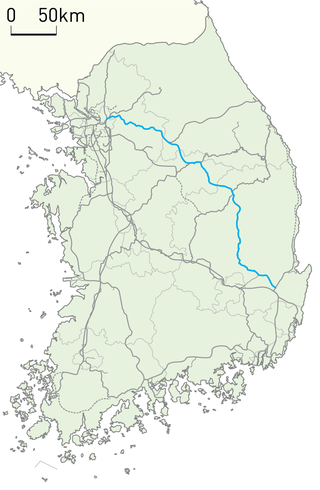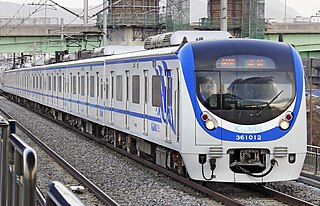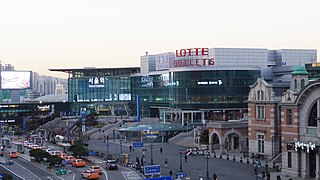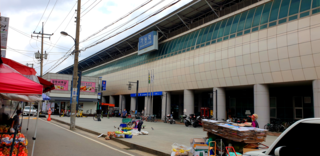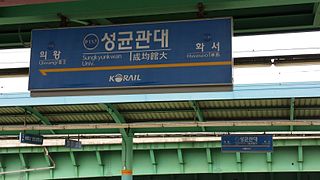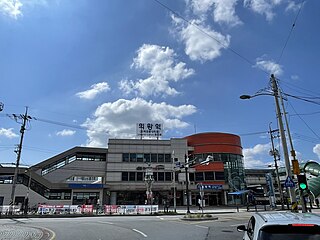| Line 1 | |
|---|---|
| | |
  Seoul Metro 1000 series EMU in December 2017 (bottom) Korail Class 311000 series EMU in February 2021 (top) | |
| Overview | |
| Native name | 1호선(一號線) Il Hoseon |
| Status | Operational |
| Owner | Seoul Special City, South Korean Government |
| Line number | 1 |
| Locale | Seoul Capital Area |
| Termini | |
| Stations | 102 Seoul Metro: 10 Korail: 92 |
| Service | |
| Type | Rapid transit / Commuter Rail |
| System | Seoul Metropolitan Subway |
| Services | Local: Yeoncheon / Soyosan / Dongducheon ↔ Incheon, Kwangwoon U ↔ Seodongtan / Cheonan / Sinchang, Yeongdeungpo ↔ Gwangmyeong Express: Cheongnyangni ↔ Cheonan / Sinchang, Dongducheon ↔ Incheon (AM Rush & off-peak weekdays), Yongsan ↔ Dongincheon, Seoul Station ↔ Cheonan/Sinchang (weekday RH, peak direction only) |
| Operator(s) | Seoul Metro, Korail |
| History | |
| Opened | August 15, 1974 |
| Technical | |
| Line length | 218.3 km (135.6 mi) Seoul Metro: 7.8 km (4.8 mi) [1] Korail: 210.5 km (130.8 mi) |
| Track gauge | 1,435 mm (4 ft 8+1⁄2 in) standard gauge |
| Electrification | 1,500 V DC (Seoul Metro section) 25 kV AC at 60 Hz (Korail section) |
| Operating speed | 110 km/h (68 mph) |
Seoul Subway Line 1 (dubbed The Dark Blue Line) of the Seoul Metropolitan Subway is a rapid transit and commuter rail line which links central Seoul, South Korea to Yeoncheon in the northeast, Incheon in the southwest, and Sinchang via Suwon and Cheonan in the south. The central underground portion of Line 1, running underneath Sejongno, Jongno, and Wangsan-ro avenues along Seoul's traditional downtown area, is the oldest subway-operated section in the Seoul Metropolitan Subway system. Its branches and services cover a large part of the Seoul Capital Area; totaling 218.3 km (135.6 mi) in route length.
The underground section between Seoul Station and Cheongnyangni station, which is referred to as Seoul Metro Line 1 (7.8 km [4.8 mi]) after its operator, is currently operated by Seoul Metro, and is electrified at the subway standard of 1,500 V DC. [1] [2] The line first opened in 1974 as the Korean National Railroad of Seoul with through services to newly-electrified (at the mainline KNR standard of 25 kV AC 60 Hz) national mainline railways from Seongbuk station (now: Kwangwoon University station) to Incheon and Suwon Stations. [3] This was the first electrified rapid transit line and service in South Korea and the second in the Korean Peninsula after the Pyongyang Metro in North Korea opened the year before.
Frequent service is provided between Soyosan, Dongducheon, Uijeongbu, Cheongnyangni, Seoul, Yongsan, and Guro, where trains split between Incheon in the west and Byeongjeom and Cheonan in the south. Express trains operate from Yongsan and Seoul stations to Dongincheon and Sinchang stations. Trains run every 3-6 min in the central route between Seoul Station and Cheongnyangni, every 6-9 min between Seoul and Guro, every 8-10 min between Guro and Incheon and between Guro and Byeongjeom, every 10-15 min from Byeongjeom to Cheonan, and every 35 min between Cheonan and Sinchang and service up to the Dongducheon area and Soyosan station.
Service to Yeoncheon is approximately once per hour, limited due to the single track section approaching Soyosan station. This service is meant to be the replacement for the Gyeongwon line commuter trains, which began at Dongducheon station prior to its closure.
Trains travel along Gyeongbu (Seoul-Cheonan), Gyeongin (Guro-Incheon), Janghang (Cheonan-Sinchang), and Gyeongwon (Hoegi-Yeoncheon) railway lines. The line runs on the left-hand side of the track, as opposed to the right-hand side of the track like all other Seoul Metropolitan Subway lines (another exception to this is Seoul Subway Line 4 although it runs on the right-hand side until Namtaeryeong station, and operates on the left-hand side for the parts afterwards) [4] since railways in Korea generally run on the left side.


















